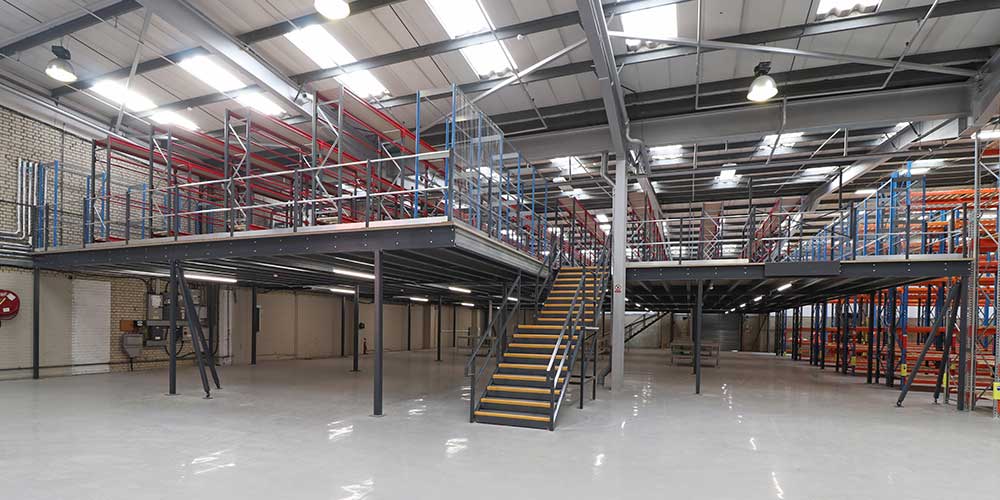Managing inventory can be a challenging task for businesses, especially those with limited space. One effective solution is using mezzanine floors. These raised platforms create additional storage space without the need for costly building expansions. Let’s explore how mezzanine floors can improve inventory management and help businesses thrive.
What is a Mezzanine Floor?
A mezzanine floor refers to a partial floor that is situated between the main levels of a structure. It adds extra space and is usually not as high as the main ceiling. Mezzanines are often used in warehouses, retail spaces, and manufacturing facilities. They provide a clever way to utilize vertical space efficiently.
Benefits of Mezzanine Floors for Inventory Management
1. Maximizes Space
One of the biggest challenges in inventory management is space. Businesses often struggle to find room for all their products. Mezzanines effectively double or even triple the available storage space. By building upward, businesses can store more items without moving to a larger facility. This maximization of space, provided by expert mezzanine floor manufacturers, leads to better organization and easier access to products.
2. Improves Organization
A well-organized inventory makes it easier to find items. Mezzanine floors allow businesses to create separate areas for different products. For example, a company can store seasonal items on one level and frequently sold items on another. This organization reduces time spent searching for products and helps employees work more efficiently.
3. Enhances Accessibility
With mezzanine, employees can access products quickly. Many mezzanines come with staircases or lifts, making it easier to reach high shelves. This accessibility speeds up the picking and packing process, allowing businesses to fulfill orders faster. Quick order fulfillment leads to happier customers and repeat business.
4. Offers Flexibility
Mezzanine floors are versatile. Businesses can customize them to suit their specific needs. Whether a company requires more storage for bulk items or a display area for products, a mezzanine can be designed to fit those requirements. This flexibility ensures that businesses can adapt to changing inventory needs without major renovations.
5. Reduces Clutter
Clutter can hinder productivity. When inventory is piled up, it becomes challenging to find items and manage stock levels. Mezzanines floors help eliminate clutter by providing dedicated storage areas. With everything organized and easy to find, employees can focus on their tasks instead of wasting time navigating through disorganized spaces.
6. Improves Safety
Safety is crucial in any workplace. A messy inventory area can lead to accidents and injuries. Mezzanine floors help improve safety by creating clear pathways for employees. By keeping items organized and stored properly, businesses can reduce the risk of accidents. Additionally, mezzanines often come with safety features, such as guardrails, to ensure employee safety while working at height.
7. Boosts Productivity
When inventory management is organized, employees can work more efficiently. Mezzanines contribute to this productivity by allowing for streamlined operations. With easy access to products and a clutter-free environment, employees can pick and pack orders more quickly. Increased productivity leads to higher production and improved overall business performance.
8. Cost-Effective Solution
Building a new facility can be expensive. Mezzanine floors provide a cost-effective alternative. Instead of moving to a larger building, businesses can install a mezzanine to create additional space. This investment often pays off quickly as businesses benefit from improved inventory management and increased storage capacity.
Tips for Implementing Mezzanine
If you’re considering adding a mezzanine floor for better inventory management, here are some tips:
1. Assess Your Needs
Before installing a mezzanine, evaluate your current inventory and storage requirements. Determine how much additional space you need and what items will go on the mezzanine. This assessment will help you design an effective storage solution.
2. Choose the Right Materials
Mezzanines can be built using various materials, such as steel or wood. Select materials that suit your business needs and comply with safety regulations. Durable materials will ensure the mezzanine can support your inventory weight.
3. Plan for Safety
Safety should always be a priority. Ensure that the mezzanine is designed with safety features like guardrails and non-slip surfaces. Also, provide proper training for employees on how to use the mezzanine safely.
4. Organize Efficiently
Once the mezzanine is in place, take time to organize it effectively. Use labels, shelves, and bins to categorize items. An organized mezzanine will help employees find products quickly and easily.
5. Regularly Review Your Inventory
As your business grows, your inventory needs may change. Regularly review your inventory and adjust your mezzanine setup as necessary. This ongoing assessment ensures that your storage solution remains effective over time.
Conclusion
Mezzanine floors are an excellent solution for businesses looking to improve their inventory management. They maximize space, enhance organization, boost productivity, and provide a cost-effective way to manage inventory. By implementing a mezzanine, businesses can create a safer, more efficient working environment.
If you’re struggling with inventory management, consider adding a mezzanine to your space. This investment can lead to significant improvements in your operations. For top-quality mezzanine solutions, consider reaching out to Plannco Steel Products Company, known for their reliable and durable designs.



